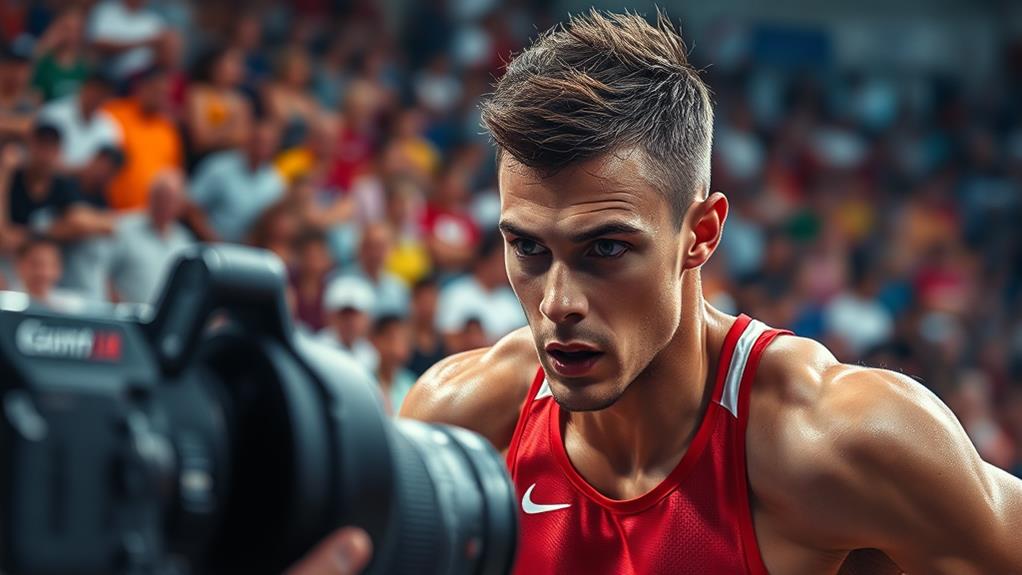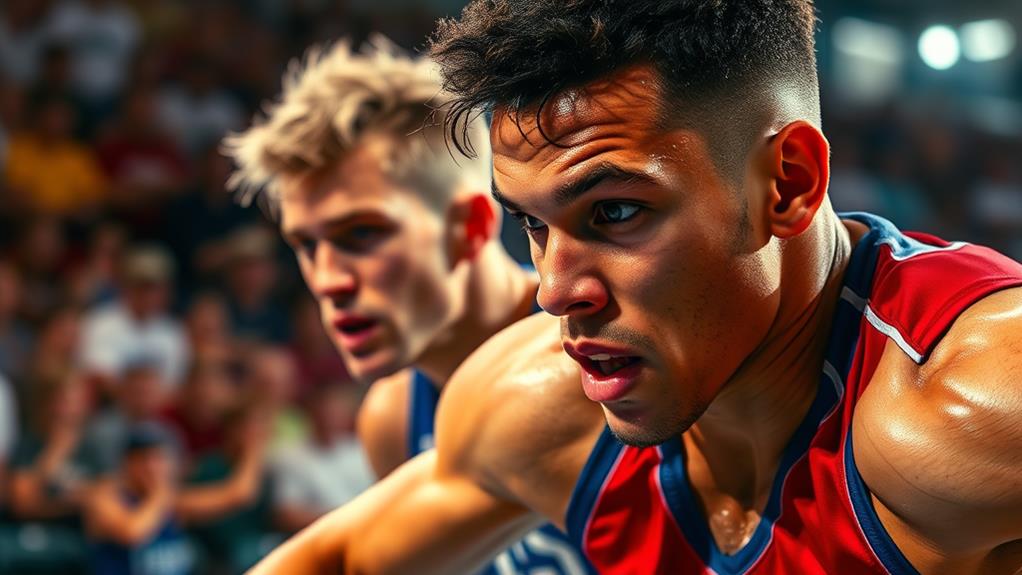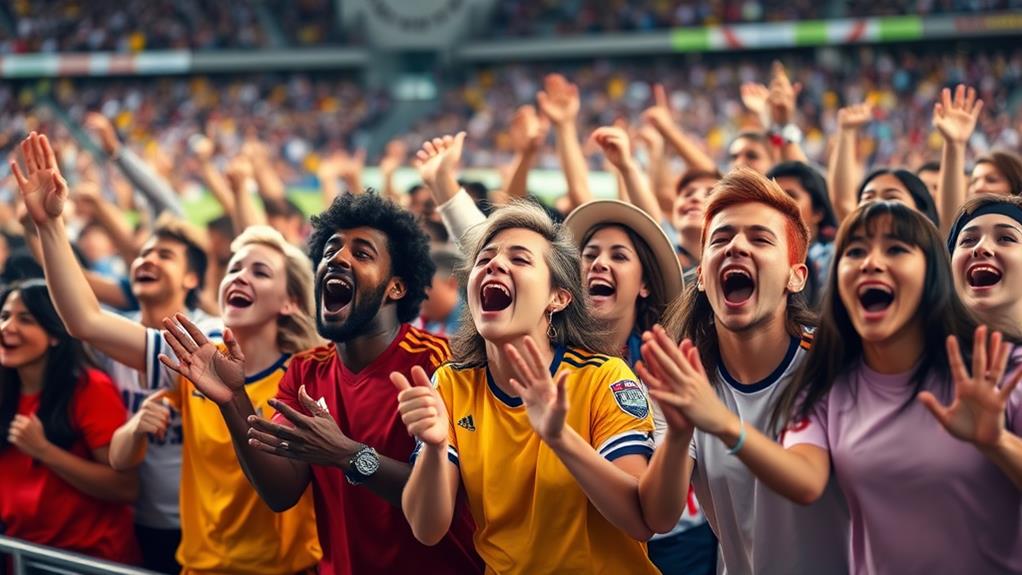Sports photography captures the essence of competition by freezing adrenaline-fueled moments that resonate with athletes and fans.
To achieve this, photographers use high-end cameras and telephoto lenses to shoot at lightning speed, ensuring no thrilling moment goes unnoticed.
Techniques like panning and fast shutter speeds bring images to life, immersing viewers in the action. For instance, panning involves tracking a moving subject with the camera, creating a blurred background that emphasizes the athlete's movement. Fast shutter speeds, on the other hand, enable photographers to freeze fast-paced action, revealing details that would be impossible to see with the naked eye.
Connecting with the sports community is crucial in telling authentic stories behind each shot. By understanding the athletes' perspectives, photographers can capture candid moments that reveal their emotions, struggles, and triumphs.
This connection also helps photographers anticipate and prepare for key moments in the game, allowing them to capture the most compelling images.
Definition and Importance of Sports Photography

Sports photography is a unique blend of art and journalism that captures the energy and emotion of athletic competitions. It requires more than just taking pictures; it demands capturing the essence of the human spirit in moments of intense determination.
To excel in this field, photographers must be prepared to seize split-second instances that tell powerful stories.
The importance of sports photography lies in its ability to convey narratives that resonate with fans and participants. Each iconic shot has the potential to evoke emotions, such as the joy of victory or the agony of defeat.
Advances in technology have enabled photographers to capture high-speed action with incredible clarity, preserving every detail for posterity.
Sports photography has evolved significantly over time, from pioneers like Eadweard Muybridge to today's cutting-edge techniques.
It shapes perceptions of athletes and immortalizes memorable moments in sports history, making it an essential part of the sporting world.
Essential Equipment for Capturing Action
Capturing Action with the Right Camera
To capture the thrill of athletic events, a high-end camera is essential. DSLR or mirrorless cameras like the Canon EOS-1D X Mark III or Sony a9 II provide fast burst rates and accurate autofocus, allowing photographers to seize peak moments in action.
Telephoto Lenses for Clarity
Telephoto lenses are crucial for shooting distant athletes with clarity. Lenses like the Canon EF 70-200mm f/2.8L maintain focus during dynamic movements, ensuring photographers don't miss a second of the excitement.
Using a monopod adds stability, especially when wielding heavy lenses throughout long events, to combat camera shake.
High-Speed Memory Cards for Continuous Shooting
High-speed memory cards are a must-have for continuous shooting. They allow photographers to shoot rapidly without lag and capture multiple frames in succession, ensuring they don't miss a moment of the action.
Protective Gear for Outdoor Conditions
Protective gear is vital for safeguarding equipment against unpredictable outdoor conditions. Weatherproof camera bags and lens covers ensure photographers are always ready to capture the action, rain or shine.
Techniques for Stunning Sports Imagery

Mastering Techniques for Stunning Sports Imagery
Capturing the essence of a game requires more than just the right gear; it demands mastery of techniques that elevate your images. In sports photography, the panning technique is essential. By using a slower shutter speed while tracking a moving athlete, you create a sense of motion in the background, enhancing the dynamic feel of your shots.
For example, when photographing a sprinter, a slower shutter speed will blur the background, emphasizing the athlete's speed and motion.
Freezing action is crucial for capturing intensity. To achieve this, use a fast shutter speed of at least 1/1000th of a second. This ensures that every detail shines, from the determination etched on an athlete's face to the swift movements of their limbs.
For instance, when photographing a football player making a tackle, a fast shutter speed will freeze the action, showcasing the intensity of the moment.
Anticipation and positioning are key to capturing decisive moments. Studying the sport helps you predict key moments, allowing for those decisive captures that tell a story.
Incorporating wide-angle shots showcases the action and immerses viewers in the environment and crowd, capturing the essence of the competition.
Close-up details revealed by telephoto lenses highlight the emotional and physical intensity, making the viewer feel the thrill of the game.
How Can Sports Photography Capture the Essence of Sports Memorabilia and Collectibles?
Sports photography plays a crucial role in capturing the essence of sports memorabilia and collectibles. High-quality images showcasing rare items can significantly impact the sports memorabilia market. Through compelling visuals, photographers can evoke emotions, highlight details, and preserve the legacy of sports collectibles for enthusiasts and investors alike.
The Evolution of Sports Photography
The world of sports photography has undergone significant transformations since its inception, revolutionizing how we capture and experience athletic moments.
Foundational Era: Late 19th Century
In the late 19th century, pioneers like Eadweard Muybridge used advancements in camera technology to create the first dynamic captures of athletic events. This foundational work in sequential photography set the stage for understanding motion, enabling photographers to capture fast-paced action. Muybridge's innovations allowed for the creation of series of photographs that, when displayed in rapid succession, created the illusion of motion.
Advancements Era: Late 20th Century and Early 21st Century
As technology advanced, particularly in the late 20th and early 21st centuries, high-speed cameras and digital photography emerged. These innovations allowed photographers to freeze moments that were once incredibly challenging to capture. Iconic sports photographers like Neil Leifer and Walter Iooss defined the visual language of sports photography, elevating its cultural significance. Leifer's work in the 1960s and 1970s, for example, showcased his ability to capture intimate moments in sports, while Iooss's use of vibrant colors and unique perspectives redefined the genre.
Digital Era: Current Era
Today, the evolution of sports photography extends beyond traditional print media. Online platforms and social media provide the ability to share and disseminate iconic sports moments instantly, reaching a broader audience than ever before. This shift has enabled emerging artists to showcase their work and connect with a global audience.
| Era | Key Innovations | Notable Photographers |
|---|---|---|
| Late 19th Century | Sequential Techniques | Eadweard Muybridge |
| Late 20th Century | High-Speed Cameras | Neil Leifer |
| Early 21st Century | Digital Photography | Walter Iooss |
| Current Era | Social Media | Various Emerging Artists |
Engaging With the Sports Community

Connecting with the Sports Community
Engaging with athletes, coaches, and fans helps photographers gain valuable insights into the sport, enabling them to capture authentic moments that resonate with viewers. For example, understanding the strategies and emotions involved in a game allows photographers to showcase the passion and intensity of competition.
This connection can be achieved by attending local sporting events, which also provide opportunities to network with fellow photographers and learn from their experiences.
Collaboration and Learning
Participating in local sporting events facilitates collaboration with fellow photographers, allowing them to share techniques and experiences that enrich their craft.
Social media platforms like Instagram and Twitter are essential for showcasing work and connecting with the sports community. Additionally, attending workshops and seminars focused on sports photography enhances technical knowledge and solidifies relationships within the community.
Behind-the-Scenes Access
By engaging with the sports community, photographers can gain behind-the-scenes access and unique perspectives that deepen their visual narratives.
This allows them to create personalized stories that showcase the human side of sports.
Immersing oneself in the sports world elevates photography and contributes to the vibrant tapestry of the community.
Questions and Answers
Is Sports Photography Competitive?
Sports photography is an extremely competitive field. To succeed, you need to be prepared to capture the best shots of athlete emotions and pivotal moments in high-pressure situations.
Event preparation is crucial, which means knowing the venue and the players inside out. This knowledge helps you anticipate and capture unique angles that set your work apart.
Having the right camera gear and shooting techniques is essential. For instance, using a high-frame-rate camera and mastering techniques like panning and burst mode can help you freeze fast-moving action and capture dramatic moments.
Staying sharp and innovative is vital, as the demand for stunning images is high, and editors and fans are always looking for fresh perspectives.
What Should a Photographer Increase When Trying to Photograph a Sports Event?
When photographing a sports event, increase your shutter speed to at least 1/1000th of a second to freeze fast-paced action effectively. This allows you to capture sharp images of athletes in motion.
Choose the right lens, such as a telephoto lens with a focal length of 70-200mm or 100-400mm, to zoom in on distant plays and get up close to the action without physically being on the field.
Adjust your camera settings according to lighting conditions, taking into account the time of day, weather, and stadium lighting.
For example, in bright sunlight, use a lower ISO and a narrower aperture to avoid overexposure.
Utilize composition techniques, such as the rule of thirds and leading lines, to create engaging frames that draw the viewer's attention to the action.
Refine your timing strategy to capture split-second moments, anticipating key plays and being ready to shoot at a moment's notice.
Practice panning, which involves following the action with your camera, to capture sharp images of moving subjects.
What Is the Best Focus for Sports Photography?
Mastering Focus Techniques is Crucial in Sports Photography
To capture sharp images in sports photography, mastering focus techniques is essential. Continuous autofocus modes are particularly effective in tracking fast-moving subjects. This technique allows the camera to continuously focus on the subject as it moves, ensuring a sharp image.
Lens Selection Matters
A lens with a wide aperture, such as f/2.8, is ideal for sports photography. This aperture setting enables you to isolate your subject and blur the background, creating a professional-looking image.
Shutter Speed is Critical
Maintaining a high shutter speed is vital in sports photography to freeze fast action and ensure sharpness. A minimum shutter speed of 1/1000th of a second is recommended to capture sharp images of moving subjects.
Adapting to the Dynamic Nature of the Event
Experimenting with different autofocus modes is necessary to adapt to the dynamic nature of the event.
Single-shot autofocus is suitable for static subjects, while continuous autofocus is better for tracking moving subjects. Understanding the strengths of each autofocus mode ensures you capture every crucial moment with precision and clarity.
What Is Unique About Sports Photography?
Sports photography is unique because it requires capturing fast-paced action while conveying athlete emotions in real-time.
To achieve this, photographers face unique lighting challenges that demand smart equipment choices. For example, they often use high-speed DSLRs to freeze fast-moving subjects and telephoto lenses to get up close and personal with the action from a distance.
Effective storytelling techniques are also crucial in sports photography. Photographers must weave together the intensity of the moment with the passion of the crowd to create a vivid narrative that resonates with viewers.
This blend of action and emotion pulls viewers into the heart of the competition, making them feel like they're part of the game.